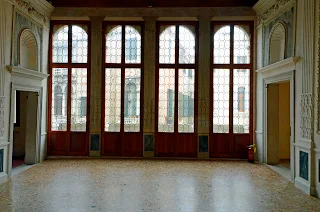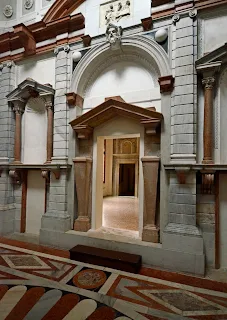At first sight, from a small ponte, there is something different about the Palazzo Grimani. It is classical, not gothic, Venetian Gothic, with the arabesque arches and off center fenestration on the facade. The Grimani has no facade, it is more or less uniform in its classical arched windows and penetrations on all sides.
Here it is visible as one approaches by boat, the service and main entry is one large arched doorway, the whole set at a place where the canal widens at an intersection, allowing maneuverable space for any boat that can get there.
The land entry is similar in size and is at the end of a calle, marked by a rusticated entry and an elaborate window above. It sends a message that this is different from the plebian calle, but it does not have the impressive facade we usually associate with a Venetian palazzo.
It has been a Grimani Palazzo for centuries, in 1532 Giovanni Grimani inherited as a typical Venetian palazzo. Giovanni started to expand it with the help of probably several architects, such as Sansovino and Palladio, but it is thought that he did much of the design himself. He was an passionate collector of antica and contemporary art, much of his collection is now in the Corrier Museum. A man of the Renaissance he was also a Bishop of the church and Patriarch of Aquileia. His expansion doubled the size of the palazzo, generated the commodious square courtyard and the beautiful well proportioned rooms in the upper quarters, all in the classical style of the intelligencia of the time. Quite unlike Venice itself.
The last Grimani in line died in 1865, and by 1960 most of the remaining valuables had been sold and the building was in a state of abandonment. In 1981, the city of Venice purchased it and started a complete resurection in 2001. It has been open to the public for only 3 years. It is unquestionably a most generous and welcoming building.
* * * * * * * * *
The entry.
Here the generous sensibility of the courtyard, and its simultaneous utility is evident, inside...
...the entry stair is totally welcoming, service entries are elsewhere.
And looking down from the loggia above, Giovanni could see his guests arrive and greet them with aplomb.
And at the end of this grand entry room, he could view down to the canal and loading area.
The ponte is seen beyond.
His public rooms are the coup though,
Here is one with a garden painted on the ceiling.
and a view to one of his sculptures through the door.
This fine room in the high mannerist style is beautifully restored.
And this: La Tribuna.
With light from above...
This super-Michaelangelesque room was filled with Giovanni's sculptures
from antiquity in the niches, on the brackets, and just about everywhere.
The Bosch show, which ended yesterday, is represented in the lower right. The 3 Bosch paintings were painted in Venice in the 3-4 years around 1500, and were housed in the palazzo before
Giovanni gave them to the Venetian state.
Showing the depth of the wall and the available space for the 130 antiqua now at the Corrier.
And
Zeus grasping Ganymede
Hanging from is original (Grimani) position after almost 500 years...
The last Grimani in line died in 1865, and by 1960 most of the remaining valuables had been sold and the building was in a state of abandonment. In 1981, the city of Venice purchased it and started a complete resurection in 2001. It has been open to the public for only 3 years. It is unquestionably a most generous and welcoming building.
* * * * * * * * *
The entry.
Here the generous sensibility of the courtyard, and its simultaneous utility is evident, inside...
...the entry stair is totally welcoming, service entries are elsewhere.
And looking down from the loggia above, Giovanni could see his guests arrive and greet them with aplomb.
And at the end of this grand entry room, he could view down to the canal and loading area.
The ponte is seen beyond.
His public rooms are the coup though,
Here is one with a garden painted on the ceiling.
and a view to one of his sculptures through the door.
This fine room in the high mannerist style is beautifully restored.
And this: La Tribuna.
With light from above...
This super-Michaelangelesque room was filled with Giovanni's sculptures
from antiquity in the niches, on the brackets, and just about everywhere.
The Bosch show, which ended yesterday, is represented in the lower right. The 3 Bosch paintings were painted in Venice in the 3-4 years around 1500, and were housed in the palazzo before
Giovanni gave them to the Venetian state.
Showing the depth of the wall and the available space for the 130 antiqua now at the Corrier.
And
Zeus grasping Ganymede
Hanging from is original (Grimani) position after almost 500 years...














Beautiful photos of places I like. Very good view.
ReplyDelete